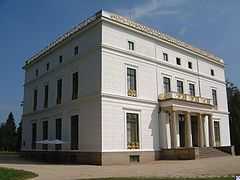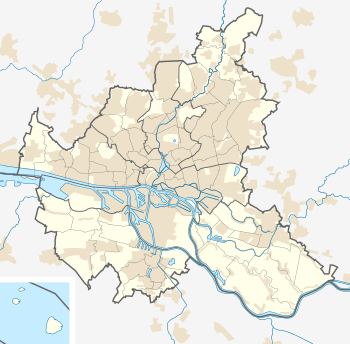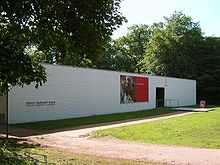Jenisch House
| Jenisch House | |
|---|---|
| Jenisch-Haus | |
 Front elevation (2004) | |
 Shown within Hamburg | |
| General information | |
| Type | Country house |
| Architectural style | Neoclassical |
| Location | Borough of Altona |
| Address |
Jenisch Park Othmarschen Baron-Voght-Str. 50, Hamburg |
| Coordinates | 53°33′09″N 9°51′56″E / 53.5525°N 9.8655°E |
| Construction started | 1831 |
| Completed | 1834 |
| Technical details | |
| Floor count | 4 |
| Design and construction | |
| Architect |
Franz Forsmann Karl Friedrich Schinkel |
Jenisch House (Jenisch-Haus) is a country house in Hamburg built in the 19th century and an example of Hanseatic lifestyle and neoclassical architecture. As of 2008, Jenisch House is the home of the Museum für Kunst und Kultur an der Elbe.
History
The house was built by Franz Forsmann and Karl Schinkel for Martin Johann Jenisch between 1831 and 1834. Jenisch used it as a country house.[1]
Location

Jenisch House is located in Jenisch Park, Hamburg's oldest landscaped park and a protected area of 43 ha (110 acres).[2] The park was landscaped by Caspar Voght as a model farm and arboretum about 1800.[3] It is located in the former independent locality of Klein Flottbek, now part of the Othmarschen quarter of Hamburg with a view toward the Elbe river, often described as "magnificent".[2] In 1828 Jenisch bought the farm and gardens from Voght and redesigned the area with the construction of his house.[4] Jenisch Park participated in the Tag des offenen Denkmals ("Day of the Open Heritage Site"), a national annual event of the Deutsche Stiftung Denkmalschutz, opening cultural heritage sites to the public, in 2007 and 2008.[5][6]
Architecture
The house is designed as a large cube, with a basement, two main floors and an attic floor. The windows are in a 1-3-1 ratio and focus on the center. On the main floors the windows reach almost completely from the floor to the ceiling. The front of the house toward the park and Elbe river has a Doric portico, supporting a balcony. The large windows, the balcony, and the house opening into the park represent the relationship between architecture and nature.[7]
Functions
The ground floor has prestigious salons, while the first floor contained the living areas and the attics were for the servants.[7] As of 2008, the Museum für Kunst und Kultur an der Elbe is located in Jenisch House, using it for exhibitions, marriages and other events. A terrace is occupied by a café for the museum.[1]
Neighborhood

The house is located directly on the right bank of the Elbe river, near the Botanischer Garten Hamburg. The street Elbchaussee has many listed buildings; Jenisch House and Park are listed also.[8] The Ernst Barlach House, located in the park, is a museum for the work of the expressionist sculptor, printmaker and writer Ernst Barlach (1870–1938).[9]
See also
References
- ↑ 1.0 1.1 "Über das Jenisch Haus" (in German). Museum für Kunst und Kultur an der Elbe. Retrieved 2009-08-26.
- ↑ 2.0 2.1 "Recommended - Three tips for a trip to Hamburg". Deutsche Welle. Retrieved 2009-08-26.
- ↑ "Jenischpark" (in German). hamburg.de. Retrieved 2009-08-26.
- ↑ "Der Jenisch-Park" (in German). Körber Stiftung. Retrieved 2009-08-26.
- ↑ "Tag des offenen Denkmals 2007" (in German). Behörde für Kultur, Sport und Medien (Ministry of Culture, Sports and Media). June 2007. Retrieved 2009-08-29.
- ↑ "Tag des offenen Denkmals 2008" (in German). Behörde für Kultur, Sport und Medien (Ministry of Culture, Sports and Media). June 2008. Retrieved 2009-08-29.
- ↑ 7.0 7.1 Julia Berger (2003). In the Valley of the Kings. Patriotism, Cosmopolitanism, and National Culture Public culture in Hamburg 1700 – 1933. Amsterdam: Rodopi. p. 127. ISBN 90-420-1185-8.
- ↑ "Verzeichnis der erkannten Denkmäler nach § 7a Hamburgisches Denkmalschutzgesetz. Band I, Teil II (F-K)" (in German). Behörde für Kultur, Sport und Medien (Ministry of Culture, Sports and Media). 2009-03-10. Retrieved 2009-08-26.
- ↑ "Ernst Barlach Haus Hamburg". Ernst Barlach Haus. Retrieved 2009-08-26.
External links
| Wikimedia Commons has media related to Jenisch House. |
- Website of the museum. Retrieved 2009-08-26. (German)